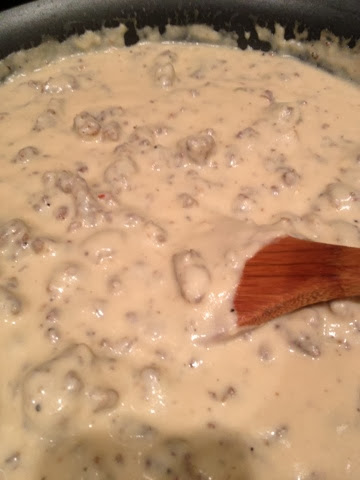Today was the first time I made biscuits and gravy. That seems like the epitome of country cooking, but somehow I missed that cooking lesson from my grandparents. I remember watching them make it for church functions so I had the basic concept in mind.
So here is the general concept of gravy:
1) Brown 1 lb of sausage into crumbles. I used mild sausage, but I think any would work. Also, to save time crumbling the sausage in little bits, I cut one end of the sausage roll off and then used my fingers to pull small chunks and put them in the pan in a single layer.
2) Once the sausage is brown and in small-ish bits you need to make a rue. A rue is a fancy term meaning add flour to a fat to create almost a paste. Brown the paste for a bit to add flavor. To do this to our sausage you can either remove the sausage with a slotted spoon and leave the grease in the pan, or leave everything in the pan and just add the flour on top of the sausage. Today, I tried to remove the sausage and then add flour. I added 3 Tbsp...which was too much flour. Next time I would add 1 Tbsp and then stir it in and then keep adding until it forms a good paste. Since I added too much at once, I added the sausage back to the pan and it seemed to soak up the flour well. I let it cook for a couple of minutes on medium heat until the flour was a golden brown.
3) Add whole milk. I didn't have milk...technically. I had a can of evaporated milk. So I mixed the can of cream with some water to thin it out. I poured about 1 cup in and stirred it in the rue until incorporated. Generally, add enough milk to almost cover the sausage crumbles. Let it cook on low and it will begin to thicken. Once it is thicker, add pepper to taste. Taste it. Add salt if needed. If the gravy gets too thick, just add more milk and stir in.
Biscuits:
My grandparents kept it easy. Buy biscuits in a tube and bake them. I made a quick mix I found recently in a 1970's sustainability book and made mine from scratch. There are also some in the freezer isle at the grocery store that would be good as well. Whichever works best for your family will be just fine.
The biscuits I made were awesome. They were a bit sweet, but I like sweet. Next time, I would make them thicker. I made the dough about 1/2 an inch thick, but they didn't rise much. So next time, I will try 1 inch thick.
My mom and I ate the biscuits and gravy. My dad is not a fan in general of biscuits and gravy, so I didn't take it personally. I really liked the balance of sweet biscuits and salty/savory gravy. My mom loved the gravy and the biscuits, but not together. So next time I will try altering the biscuit mix to have a little less sugar.
Overall, great breakfast. Not very healthy, but if you have a very physical day ahead of you, this might be good to get you through. Plus, it is pretty inexpensive. For the biscuits and gravy, it cost about, $5.87 (as a high estimate). Sausage=$3/lb, Flour=$0.50 (biscuits=$0.45, gravy=$0.05), Milk=$0.75, Sugar=$0.25, Eggs=$0.66, Butter=$0.66, Baking Powder=$0.05. Biscuits (12)=$2.07, Gravy=$3.80. This could easily make 6 hearty portions. Total=$0.98 per serving. Not too bad.






